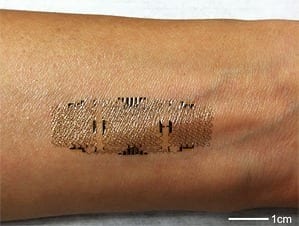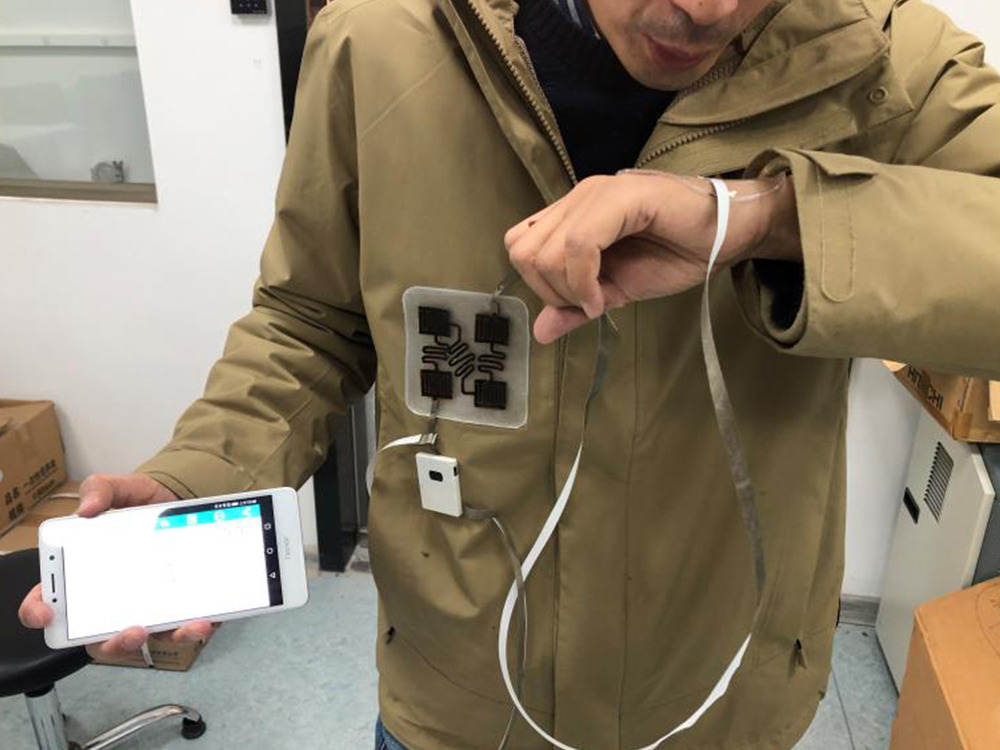
New electronic tattoos could help monitor health during normal daily activities.
So-called “epidermal electronics” were demonstrated previously in research from the lab of John Rogers, a materials scientist at the University of Illinois at Urbana-Champaign; the devices consist of ultrathin electrodes, electronics, sensors, and wireless power and communication systems. In theory, they could attach to the skin and record and transmit electrophysiological measurements for medical purposes. These early versions of the technology, which were designed to be applied to a thin, soft elastomer backing, were “fine for an office environment,” says Rogers, “but if you wanted to go swimming or take a shower they weren’t able to hold up.” Now, Rogers and his coworkers have figured out how to print the electronics right on the skin, making the device more durable and rugged.
“What we’ve found is that you don’t even need the elastomer backing,” Rogers says. “You can use a rubber stamp to just deliver the ultrathin mesh electronics directly to the surface of the skin.” The researchers also found that they could use commercially available “spray-on bandage” products to add a thin protective layer and bond the system to the skin in a “very robust way,” he says.
Eliminating the elastomer backing makes the device one-thirtieth as thick, and thus “more conformal to the kind of roughness that’s present naturally on the surface of the skin,” says Rogers. It can be worn for up to two weeks before the skin’s natural exfoliation process causes it to flake off.
During the two weeks that it’s attached, the device can measure things like temperature, strain, and the hydration state of the skin, all of which are useful in tracking general health and wellness. One specific application could be to monitor wound healing: if a doctor or nurse attached the system near a surgical wound before the patient left the hospital, it could take measurements and transmit the information wirelessly to the health-care providers.
The Latest Bing News on:
Epidermal electronics
- Wearable Sensors for Vascular Age and CVD Assessmenton May 6, 2024 at 5:59 pm
Researchers introduced a novel approach to cardiovascular health monitoring by integrating a stroke-volume allocation (SVA) model with wearable sensors. Through comprehensive experiments and clinical ...
- Automotive Electronicson May 6, 2024 at 4:59 pm
Molex has introduced MX-Dash, a family of single automotive connectors that combine power, signal and high-speed data inserts for zonal architectures. In wire-to-wire and wire-to-board form, they are ...
- Press Release Biocartis NV: Biocartis and Merck to Collaborate on Improving Patient Access to ...on May 5, 2024 at 10:00 pm
Biocartis and Merck to Collaborate on Improving Patient Access to Personalized Medicine in Middle East and North Africa (MEA) Region. Bioca ...
- Your guide to recycling clothing, makeup, electronics, batteries and more in Phillyon April 21, 2024 at 5:00 pm
We also tried to include companies with serious credentials wherever possible, like PAR-Recycle Works, an R2-certified electronics recycler in Nicetown that employs people returning from prison ...
- 10 Things to Know Before You Buy Refurbished Electronicson April 21, 2024 at 5:00 pm
These tips can help you get a deal and avoid being ripped off when buying refurbished laptops, TVs, phones, and other electronics. I've been writing about computers, the internet, and technology ...
- Hundreds drop off old electronics during annual recycling event in Buckheadon April 20, 2024 at 6:12 pm
Monday is Earth Day and hundreds of people took the opportunity to participate in an event aimed at recycling electronics in Buckhead on Saturday. The annual free event is organized by Georgia ...
- Don't Chuck That Tech: 7 Simple Ways to Recycle Electronicson April 17, 2024 at 5:00 pm
Need to dispose of an old TV, laptop, phone, or other gadget? There are tons of easy (and often free) ways to recycle your old gear and make sure it doesn't end up in a landfill. My title is ...
- Electronic Tattoos: The Future of Wearable Technologyon April 17, 2024 at 11:08 am
Electronic tattoos, also known as epidermal electronics or e-tattoos, are a groundbreaking development in wearable technology. Electronic tattoos are a specialized subset of electronic skin ...
- China tightens Russia payments scrutiny, hitting electronics components, say Russian mediaon April 12, 2024 at 12:24 am
Experts cited by Kommersant said China was the only supplier for such parts, and that Russian companies assembling electronics could therefore face serious difficulties and production delays.
- Electronics group Ellies headed for liquidationon April 9, 2024 at 5:00 pm
Electronics group Ellies announced on Wednesday its business rescue practitioner John Evans had concluded there are no reasonable prospects of saving the business and will apply to the court for a ...
The Latest Google Headlines on:
Epidermal electronics
[google_news title=”” keyword=”epidermal electronics” num_posts=”10″ blurb_length=”0″ show_thumb=”left”] [/vc_column_text]The Latest Bing News on:
Electronic tattoos
- How to watch the Eurovision Song Contest 2024 semi-finals and final online for FREEon May 7, 2024 at 1:10 pm
The contest’s most left field entrant will air Eurovision 2024 for FREE on SBS and its streamer, SBS On Demand. It’ll be an early start for Aussies though with a 5 a.m. AEST start time across all ...
- A woman hid her tattoos to get her corporate job, and thinks others should tooon April 30, 2024 at 5:06 am
Tattoos are becoming more common, but that doesn't mean the stigma is gone — especially in the workplace. A TikToker went viral last week after suggesting that her visible ink may have been why ...
- Tattoo aftercare: Tips and the best products to use for healing, according to expertson April 30, 2024 at 4:07 am
You chose a design, booked an artist, showed up to the studio and endured multiple hours of discomfort, but your tattoo journey isn’t over. Proper tattoo aftercare not only prevents infection ...
- 17 May Birth Flower Tattoos to Celebrate Your Birthdayon April 26, 2024 at 11:45 am
What better way to celebrate the blossoming beauty of spring than with a May birth flower tattoo? In recent years, birth flower tattoos have garnered much adoration from tattoo lovers worldwide ...
- Chaos Theory: How Justice Shattered Their Six-Year Silence in Styleon April 26, 2024 at 7:12 am
The French electronic duo delivered one of the most talked about sets at Coachella on the eve of its fourth studio album.
- 'Isn't hygiene like #1 when it comes to tattooing?'on April 24, 2024 at 5:44 am
A tattoo artist and TikTok user is calling out a recent convention after seeing the handwashing station organizers had set up for tattoo artists. For context, hand washing is an essential part of ...
- Take-Two wins lawsuit over LeBron James’ tattooson April 19, 2024 at 2:59 pm
Nicole Carpenter is a senior reporter specializing in investigative features about labor issues in the game industry, as well as the business and culture of games. A jury voted unanimously on ...
- Electronic Tattoos: The Future of Wearable Technologyon April 17, 2024 at 11:08 am
Electronic tattoos, also known as epidermal electronics or e-tattoos, are a groundbreaking development in wearable technology. Electronic tattoos are a specialized subset of electronic skin ...
- Paintable 'second skin' gel for wearable bioelectronic sensorson April 16, 2024 at 5:01 pm
While electronic tattoos made of conductive materials like metals have been used for this purpose, their weak skin adhesion and lack of electrolytes lead to motion artifacts and high impedance at the ...
- Angelina Jolie shows off new tattoo with a tie to ‘The Outsiders’ at Broadway show’s opening nighton April 15, 2024 at 12:24 pm
The actress and humanitarian showed off a fresh design on her arm at the opening of Broadway’s “The Outsiders” last week, displaying a tattoo reading “Stay Gold” in a script font.
The Latest Google Headlines on:
Electronic tattoos
[google_news title=”” keyword=”electronic tattoos” num_posts=”10″ blurb_length=”0″ show_thumb=”left”]










